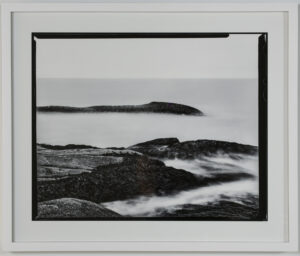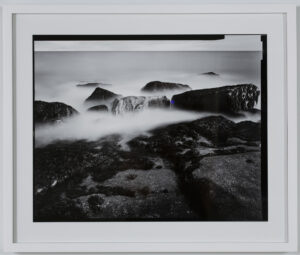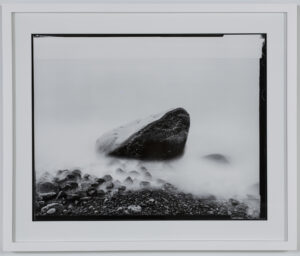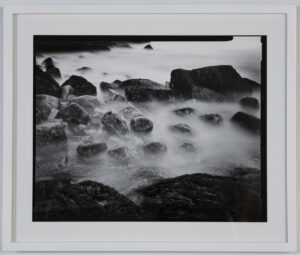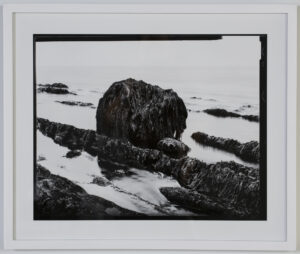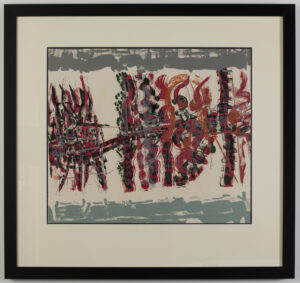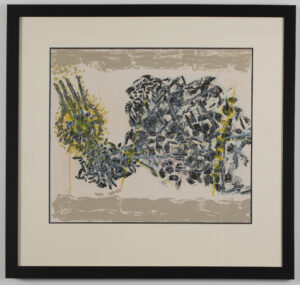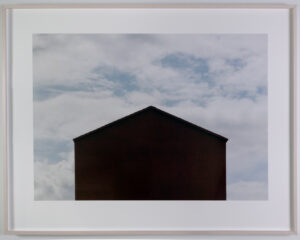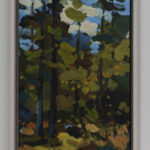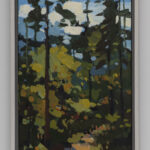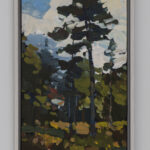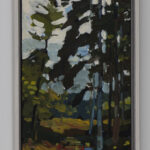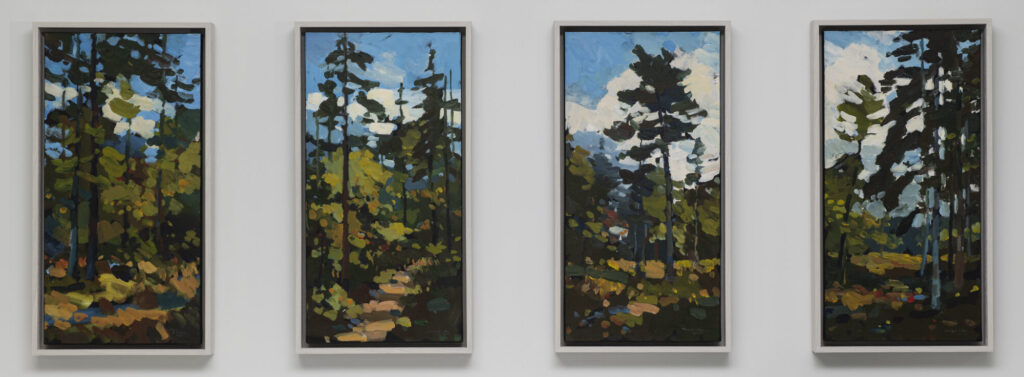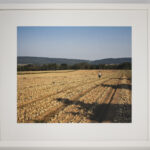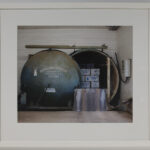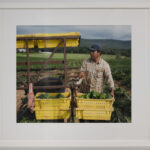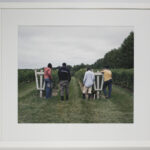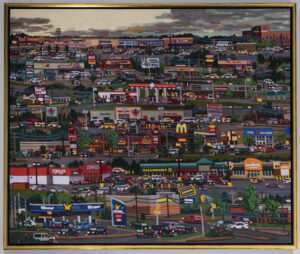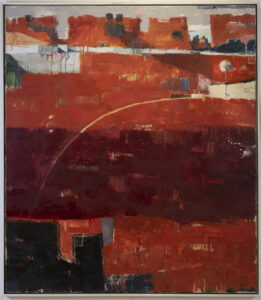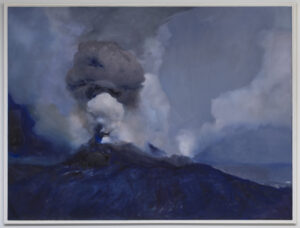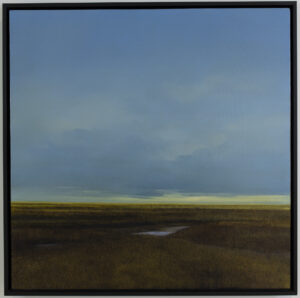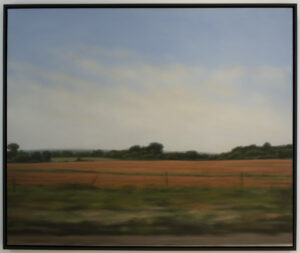Office Art
Pear – Monica MacDonald
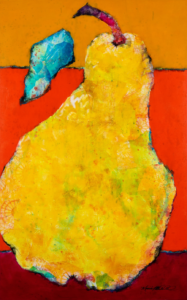
Monica MacDonald is a professional artist living and working on Prince Edward Island. Monica studied at Sir Wilfred Grenfell School of Fine Art in Corner Brook, Newfoundland and the Nova Scotia College of Art and Design in Halifax, Nova Scotia, receiving a Bachelor of Fine Art in 1996. She has been the recipient of several Arts awards and grants including PEI Council of the Arts Professional Development Grant, the New Brunswick Arts Board Emerging Artist Creation Grant, and the John Lewis Paton Scholarship from Memorial University. Recent Professional Development workshops in Florida and North Carolina have invigorated her work and led her in new directions.
Pear Chopped – Monica MacDonald
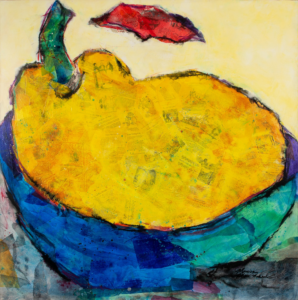
Monica MacDonald is a professional artist living and working on Prince Edward Island. Monica studied at Sir Wilfred Grenfell School of Fine Art in Corner Brook, Newfoundland and the Nova Scotia College of Art and Design in Halifax, Nova Scotia, receiving a Bachelor of Fine Art in 1996. She has been the recipient of several Arts awards and grants including PEI Council of the Arts Professional Development Grant, the New Brunswick Arts Board Emerging Artist Creation Grant, and the John Lewis Paton Scholarship from Memorial University. Recent Professional Development workshops in Florida and North Carolina have invigorated her work and led her in new directions.
Yellow Harvest Field – Dawn McCracken
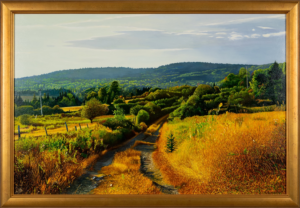
Born in Fredericton, New Brunswick, Dawn McCracken studied at the University of New Brunswick on a Beaverbrook Scholarship. She studied painting at the Art School of the Montreal Museum of Fine Arts under the tutelage of Arthur Lismer, Gentile Tondino, Jacques de Tonnancour and Moe Reinblatt. Further art studies included summer school sessions at the University of New Brunswick with Fritz Brandtner and Alfred Pinsky and at Queen’s University in Kingston, Ontario with André Bieler and George Swinton.
Dock This Way – Kim Stubbs
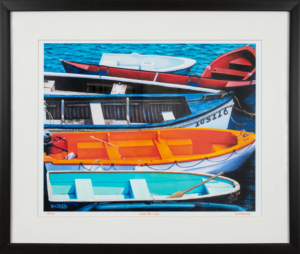
I have always been an artist within. And it was inevitable that I be a full-time ‘thriving’ artist. It wasn’t always the case… Society/peers/life had dictated that being an artist was not a profession. At least that was my paradigm. As such, I drifted in a corporate world for 30 years by day and painted by night. I am thankful for that time, the marketing and overall business knowledge, the friendships – have all sculpted me into the person I am today. But, I was not complete. My passion was laying, waiting for its time.
In late 2012 this passion sprung forth, and I fell in love with myself again. I permitted myself to be the artist that I have always been. Awaking to a more beautiful and colorful world is positive and powerful. This increased passion now flows from within onto each canvas.
River with Snow – Peter Gough
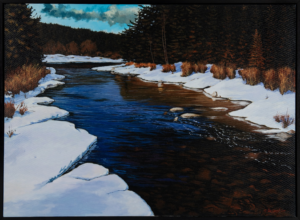
Peter Gough was born in Nova Scotia in 1947. He has a home and studio in Glen Margaret, Nova Scotia. Gough began his art education at the Nova Scotia College of Art and Design, having received a scholarship to the college in 1969. Three years later, Gough attended Andrews University in Michigan, U.S.A. and continued his Fine Art education under the influence of sculptor Alan Collins, who apprenticed with legendary Henry Moore.
A contemporary naturalist and realist painter, Gough is influenced by his rural surroundings and is constantly aware of the challenges it faces by urban progress. Firmly rooted in the physical reality of the places he chooses, at a moment in time, his paintings are imbued with a luminosity that transcends realism. “His work is sheer magic. The magic lies in the essence of light.”
Sand Bar/Water – Peter Gough
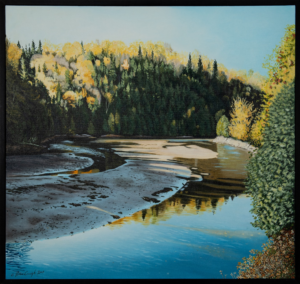
Peter Gough was born in Nova Scotia in 1947. He has a home and studio in Glen Margaret, Nova Scotia. Gough began his art education at the Nova Scotia College of Art and Design, having received a scholarship to the college in 1969. Three years later, Gough attended Andrews University in Michigan, U.S.A. and continued his Fine Art education under the influence of sculptor Alan Collins, who apprenticed with legendary Henry Moore.
A contemporary naturalist and realist painter, Gough is influenced by his rural surroundings and is constantly aware of the challenges it faces by urban progress. Firmly rooted in the physical reality of the places he chooses, at a moment in time, his paintings are imbued with a luminosity that transcends realism. “His work is sheer magic. The magic lies in the essence of light.”
Crow – Heather Millar
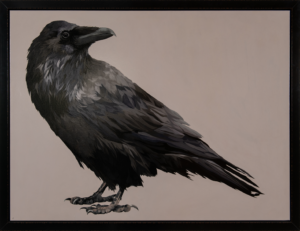
Gravitating to the idea of capturing a moment in time, Heather Millar’s work is reflective of vintage ambiance steeped in nostalgia, ranging from childhood toys, vintage family snapshots and portraiture, landscape and wildlife caught in a still moment.
“I love the idea of having something tangible to represent that moment caught in time.”
So often our memories obscure what was our reality at the time, so bringing back those images in the form of a painting on canvas lets the viewer treasure what was possibly once lost.
Keeper of Our Land – Robert Bateman
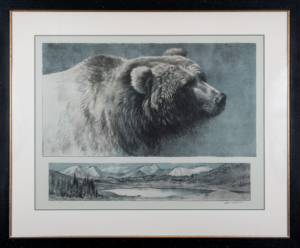
Born in Toronto, with a degree in geography from the University of Toronto, Robert Bateman taught high school for 20 years, including two years in Nigeria. He travelled around the world in 1957-58, increasing his appreciation of cultural and natural heritage. Since leaving teaching in 1976 to paint full-time, he has travelled widely with his artist/conservationist wife Birgit to many remote natural areas. The family moved to Salt Spring Island in 1985.
Bateman has been a keen artist and naturalist from his early days. He has always painted wildlife and nature, beginning with a representational style, moving through impressionism and cubism to abstract expressionism. In his early thirties he moved back to realism as a more suitable way to express the particularity of the planet. It is this style that has made him one of the foremost artists depicting the world of nature.
Sailboats – Jim Fitzpatrick
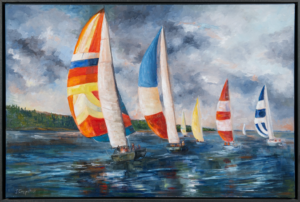
Jim Fitzpatrick, a native Californian, has been painting golf exclusively for over 25 years. After thousands of hours on the range and a dedicated amateur career, Jim went to work as a golf course designer for the international firm of Harris, Thompson (Peter), Wolveridge, Fream and Storm. Missing the Links he turned his profession to operate a golf course in Ashland, Oregon, and then spent a number of years in sales and advertising. In the early 80’s he returned to his passion, golf, this time as an artist painting golf scenes and players from around the world and throughout history.
Over the years, at his client’s requests, Jim has expanded & developed his talents to include fine pencil drawings and sculptures. He has been selected to immortalize many of golf’s greatest events, finest clubs and most distinguished players with his creations.
Path to Broadway Avenue – Jaya Krishan
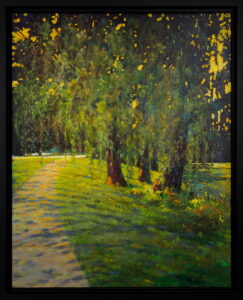
Jaya Krishnan, born in Malaysia, has lived in Ottawa CA since 1979. He briefly attended an art school in Kuala Lumpur but basically, is a self-taught artist. Jaya has experimented with various artist forms, including surreal, abstract, expressionism, cubism, realism and landscapes in the tradition of the French Barbizon School.
Lately, he has devoted his energy into painting a series of images from Asia… (Bali, Malaysia, Thailand, Laos, Cambodia and Vietnam). Jay’s interests these days is exploring human conditions and the environment with affectionate empathy.
Jaya volunteers his time to teach a weekly art class for seniors at the Abbotsford House in Ottawa. He also volunteered his time at the St. Joseph Food and Shelter program and also the Ottawa Greek Festival.
Overseas, he has volunteered at the Cambodian Children’s Painting Project at Sihanoukville and the New Cambodian Children’s Life Association in Phnom Penh with orphans, teaching art, English and other related activities. He’s been involved with the elephant Hospital project in Lampang Province, Thailand.
Jaya has travelled extensively and has worked in numerous corporate and private collections in Asia, Europe, U.S.A., Mexico and Canada.
Beaver Brook Star House – Fred Ross
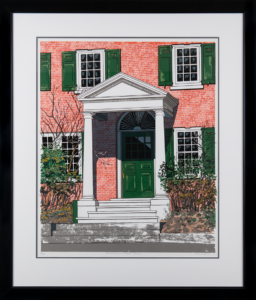
Frederick Joseph Ross was born in 1927 in Saint John, New Brunswick. In 1944, he began his art studies with Ted Campbell at the Saint John Vocational School and in 1946 painted a large mural there of the school’s annual picnic. Following studies in Mexico in 1949 with Pablo O’Higgins at Taxco, Ross returned to Saint John. In 1950, he briefly visited Mexico again, and met Diego Rivera. In 1970, he resigned his position as Supervisor of Art at the Saint John Vocational School where he had been teaching since the 1950s, to devote his time fully to painting. Although he had exhibited widely since the 1950s, the 1993 Beaverbrook Art Gallery retrospective, The Art of Fred Ross – A Timeless Humanism, secured his reputation nationally. In 2002 he was made a Member of the Order of Canada.
Somerville House – Molly Lamb-Bobak
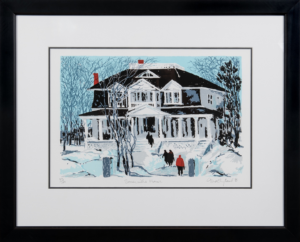
Vancouver-born artist Molly Lamb Bobak (1920–2014) was the first Canadian woman war artist. The daughter of celebrated photographer Harold Mortimer-Lamb, Bobak longed to be a painter like her family friend the Group of Seven’s A.Y. Jackson. In 1942 Bobak joined the Canadian Women’s Army Corps and was sent overseas to London where she depicted female military training as well as dynamic scenes of marches and parades—subject matter for which she would later be well known.
Upon her return from the U.K., Bobak married fellow war artist Bruno Bobak. In 1960 their family moved to Fredericton, New Brunswick, where they lived and worked for over half a century. In one of the first generations of Canadian women who earned their livings as artists, Bobak became known for her paintings, drawings, and watercolours. For her role in the Second World War and many other accomplishments she was elected to the Royal Canadian Academy of Arts in 1973 and presented with the Order of Canada in 1995.
The View from the Bridge – Molly Lamb-Bobak
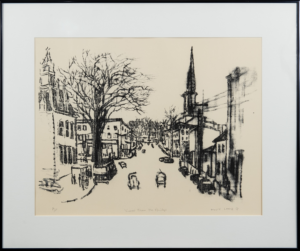
Vancouver-born artist Molly Lamb Bobak (1920–2014) was the first Canadian woman war artist. The daughter of celebrated photographer Harold Mortimer-Lamb, Bobak longed to be a painter like her family friend the Group of Seven’s A.Y. Jackson. In 1942 Bobak joined the Canadian Women’s Army Corps and was sent overseas to London where she depicted female military training as well as dynamic scenes of marches and parades—subject matter for which she would later be well known.
Upon her return from the U.K., Bobak married fellow war artist Bruno Bobak. In 1960 their family moved to Fredericton, New Brunswick, where they lived and worked for over half a century. In one of the first generations of Canadian women who earned their livings as artists, Bobak became known for her paintings, drawings, and watercolours. For her role in the Second World War and many other accomplishments she was elected to the Royal Canadian Academy of Arts in 1973 and presented with the Order of Canada in 1995.
Ludlow Hall – Bruno Bobak
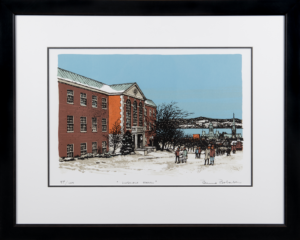
Painter, watercolourist, printmaker, sculptor and muralist, Bronislaw Josephus “Bruno” Bobak was born in 1923 in Poland, and immigrated with his family to Canada in 1925. He studied art with Arthur Lismer and Gordon Webber at the Art Gallery of Toronto (1933-37), and with Carl Schaefer and Elizabeth Wyn Wood at the Central Technical School, Toronto (1938- 42). He served in the Canadian Army (1943-46), and was an official war artist (1944-46). In 1945, he married the artist Molly Lamb. He taught at the Vancouver School of Art (1947-57), and was the artist in residence at the University of New Brunswick, Fredericton, (1960-61), and the director of the Art Centre there (1962-88). In 1973, he became a member of the Royal Canadian Academy of Arts, and in 1983, the Sir George Williams Art Galleries, Concordia University, organized a touring retrospective of his work.
The Provincial Building – Herzl Kashetsky
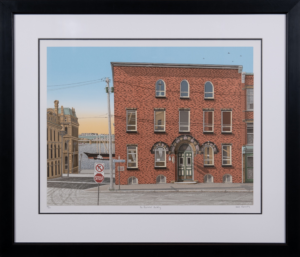
Born in Saint John, New Brunswick in 1950 her grandfather emigrated from Lithuania about 1900, B.F.A., Concordia University, Montréal, Québec (1977)
Herzl Kashetsky’s work in the early 1980s tended to reflect subjects common to the magic realist school, especially still life, focusing on every day objects with an intensity that inevitably invests them with new and deeper meaning. Initially belonging to a regional art movement centred in Atlantic Canada, the magic realists combine almost photo-realist painting with a surrealist use of light and objects to create images that superficially reflect reality, while commenting on the nature of that reality through an unusual intensity of mood. Kashetsky’s 1992 series, Beach Stones, is an example of some of his most meticulous work, following up on a theme that sprang from an 1989 series, Creation, about the seven days of Creation. In Beach Stones each painting is a loving recreation of a beach stone surface, containing dozens of stones piled together, in which each stone is treated with absolute realism, having its own particular surface and shadow. Also at this time, he was painting family portraits and self-portraits that in some ways became part of his 1996 series, A Prayer for the Dead. Although he had been occasionally painting works on the theme of death since 1974, a visit to Poland and some concentration camp sites in 1990 prompted him to create this series, which he says was his way of paying respect to the dead, to the victims of the Holocaust and also to those he has lost from his own life. He worked from photographs, explaining, “I didn’t live though the Holocaust, so I think it would be a little pretentious of me to interpret the pain and suffering. I felt I should take the facts and present them in a documentary style . . . so that you, yourself, would become a witness to the Holocaust, because you’re only twice removed” (1997). In this series Kashetsky’s style takes on a completely different, haunting tone, in the faces of those dying, a crematorium door, a mass grave, all painfully recreated to the last detail. Mass Grave, Bergen Belsen bears a strange resemblance to the beach stone series, the bodies of the dead being jumbled together just like the stones, yet each one commemorated through the artist’s careful and delicate rendering. Of the series, curator Tom Smart has said: “As I came to know Herzl and his work as an artist, I learned that his lifelong project is to bear witness to the large themes of humanity in deeply meditative works. By seeking to understand the Holocaust, he travelled on a pilgrimage to one of the death camps. His journey was not simply an artistic or experiential quest, but also a spiritual pilgrimage to understand the personal dimensions of tragic events” (1997). Kashetsky is also vice-chairman of the Saint John Advisory Board and art advisor of the Saint John Jewish Historical Museum. He has taught classes at the New Brunswick Community College. In 1992 he received an honorary doctorate from the University of New Brunswick and a commemorative medal for outstanding artistic contribution to the community, for Canada’s 125th anniversary of Confederation. In 1997 he received the New Brunswick Red Cross Humanitarian Award, and a best picture award at the 53rd annual exhibition of the Canadian Society of Painters in Watercolour.
Water, Rock, Time series (2018 – 2020) – Stephen Brookbank
- From Crow Hole, Gaff Point, Lunenburg County
- Sandy Cove, near Sambro #3
- Beach at Birch Plain, Victoria County, Cape Breton #1
- Sandy Cove, Near Sambro #2
- Cranberry Cove #3
Photographs, digital prints
Stephen Brookbank is currently the Photo Technician at NSCAD University and previously worked for Edward Burtynsky’s Toronto Image House. He is known as an aficionado of analog photography, carefully taking single shots with a large format camera. The negatives are scanned and output as digital files and edited to reflect the qualities of the negative. The Water, Rock, Time series is made since Brookbank moved to Nova Scotia. Brookbank has exhibited in public and private gallery spaces in Hamilton and Toronto and in the US. His work has been reviewed in numerous magazines including Globe & Mail Report on Business Magazine, PhotoEd Magazine, Macleans, Hamilton Spectator, Canadian Art.
See also:
Lithographs – Jean-Paul Riopelle
(66/90)
Le Sablier 1
Le Sablier 5
Jean-Paul Riopelle, (1923 – 2002) was one of Canada’s most significant 20th century artists and the first Canadian painter (since James Wilson Morrice) to attain widespread international recognition. He studied under Paul-Émile Borduas in the 1940s and was a member of Les Automatistes, a group of Montreal artists who were interested in abstractionism and automatic drawing born out of the unconscious mind. He was one of the signers of the Refus global manifesto that rejected the social, artistic and psychological norms and values of Québécois society.
His professional career got off to a flying start in 1949 with his first solo show in Paris at the Galerie La Dragonne, an occasion marked by the publication of his first exhibition catalogue, which featured a poetic text by André Breton. This was followed by numerous group shows in France, Italy, Spain, England and Sweden in the early 1950s. From 1954 onwards, he had regular exhibitions at the Pierre Matisse Gallery in New York. Galerie Maeght in Paris took him on in 1966, dedicating a show to his work every two years. The Musée national des beaux-arts du Québec devoted a retrospective to him in the summer of 1967. Later, in 1972, a major exhibition entitled Ficelles et autres jeux was held at the Canadian Cultural Centre in Paris, and at the Musée d’art moderne de la Ville de Paris. In 1981-82, the Musée national d’art moderne (Centre Georges-Pompidou) organized a major retrospective of his work that was later presented at the Musée national des beaux-arts du Québec, the Musée d’art contemporain de Montréal, and museums in Mexico and Venezuela. The Montreal Museum of Fine Arts also devoted a retrospective to Riopelle in 1991, to celebrate the inauguration of the Museum’s new Jean-Noël Desmarais Pavilion.
In 1992, it was announced that Joan Mitchell, his companion in Paris for almost 20 years, had died. Riopelle, shattered by the news, turned his hand to painting once again, producing the largest work of his career, the Hommage à Rosa Luxemburg, a triptych. It was painted on a huge canvas that Riopelle unrolled as his composition progressed; it was later hung on wooden stretchers that measured approximately 40 metres. This work is now on display at the Musée national des beaux-arts du Québec in Quebec City.
Jean Paul Riopelle died at his home on Îsle-aux-Grues on March 12, 2002.
Riopelle is best known for his abstract painting style, in particular his “mosaic” works of the 1950s when he famously abandoned the paintbrush, using only a palette knife to apply paint to canvas, giving his works a distinctive sculptural quality. In the 1960’s he added ink on paper, watercolours, lithography and collage to his artistic output. These prints are from the 1980s.
See also:
- Montreal Museum of Fine Arts mbam.qc.ca
- galeriesimonblais.com
Hobson’s Buoy, Mahone Bay, 1953 – Jack Lorimer Gray
Oil on canvas
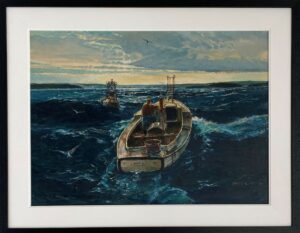
Jack Lorimer Gray, 1927-1981, was born in Halifax, Nova Scotia to Scottish parents. His talents as an artist were spotted by E. Wyly Grier while Gray was still a child. He attended the Nova Scotia College of Art for one year, but left to work on fishing boats. He was an excellent sailor, which is reflected in his paintings of fishermen, boats, and the piers and buildings of the waterfront.
This piece was graciously gifted to the Firm by Sally Covert, daughter of Stewart McKelvey founding partner, Frank Manning Covert, Q.C., O.C., 1908-1987.
The First Tulips – Alexandrya Eaton
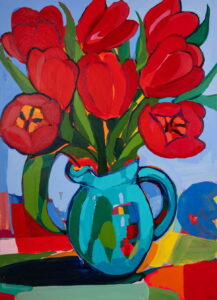
Alexandrya Eaton is a contemporary Canadian painter whose studio practice has grown to include rug-hooking and weaving, incorporating the same vibrant palette and simplified shapes across all mediums. Alexandrya’s work aims to explore phases of womanhood, combining traditional textile techniques with contemporary imagery.
Young Blue Female Moose (2021) – Alan Syliboy
Oil on canvas
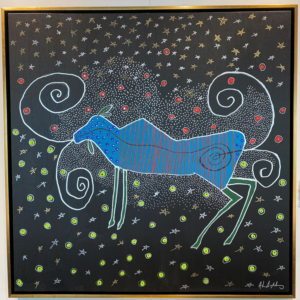
Alan Syliboy grew up believing that native art was generic. “As a youth, I found painting difficult and painful, because I was unsure of my identity.” But his confidence grew in 1972 when he studied privately with Shirley Bear. He then attended the Nova Scotia College of Art and Design, where 25 years later, he was invited to sit on the Board of Governors. Syliboy looks to the indigenous Mi’kmaq petroglyph tradition for inspiration and developed his own artistic vocabulary out of those forms. His popularization of these symbolic icons has conferred on them a mainstream legitimacy that restores community pride in its Mi’kmaq heritage.
“I was told a story by a medicine man that had a horse which was old and dying. When the horse passed it had a blue glow around it. I felt that this blue glow represented the spirit leaving the body. This Young Blue Female Moose is nearing death, and its spirit is beginning the journey back to the creator.”
Whale Rider (2021) – Alan Syliboy
Oil on canvas
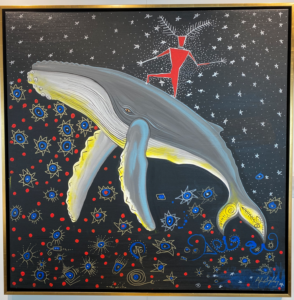
Alan Syliboy grew up believing that native art was generic. “As a youth, I found painting difficult and painful, because I was unsure of my identity.” But his confidence grew in 1972 when he studied privately with Shirley Bear. He then attended the Nova Scotia College of Art and Design, where 25 years later, he was invited to sit on the Board of Governors. Syliboy looks to the indigenous Mi’kmaq petroglyph tradition for inspiration and developed his own artistic vocabulary out of those forms. His popularization of these symbolic icons has conferred on them a mainstream legitimacy that restores community pride in its Mi’kmaq heritage.
“The Whale Rider represents man’s similarities to the whale and the close connection that we have with these creatures. It is said that the Whale writes the history of Mother Earth. It still has a connection to the land as it must surface to breathe. Its songs are about the relationship between the Universe and Mother Earth.”
History of a Place (2019) – Ned Pratt
Photograph, chromogenic print
Ned Pratt’s artistic vision is the result of years of experience and a discerning eye for the superfluous and the essential. Pratt says of his work:
“Simple structures, whose beauty is more difficult to find in the surrounding landscape interest me. The subtle intrusion into the landscape such as stone cracked by freezing and thawing due to exposure to the elements, simple pole lines breaking a simple horizon line with almost indistinguishable tonal qualities, or a red stripe from a tractor parked on the roadside are images that inspire me; but it is the the landscape that endures; it is the landscape that remains in control.”
Ned Pratt was born and lives in Newfoundland & Labrador. He holds a BFA in photography from the Nova Scotia College of Art and Design and a BA in art history from Acadia University. His photography has been exhibited at the former Art Gallery of Newfoundland and Labrador, the McMichael Canadian Art Collection, PREFIX Photo, the Scotiabank Contact Photography Festival (2012) and in Oh, Canada: Contemporary Art from North America at the Massachusetts Museum of Contemporary Art (touring from 2012–16). He holds the 2017 Large Year Award from Visual Artists Newfoundland and Labrador for Excellence in the Visual Arts. His work has been written about in various publications, including Canadian Art, CBC Arts, Momus, and Mason Journal. Pratt’s photographs are held in major public and corporate collections across Canada, the United States, Europe, and Australia.
See also:
Untitled (2012) – Mark Grantham
Four panels
Oil on canvas
A fifth-generation Haligonian, Mark Grantham received his Bachelor of Arts and Bachelor of Education degrees from Dalhousie University and went on to study architecture at the Technical University of Nova Scotia, from which he holds a Bachelor of Environmental Design Studies degree as well as a Masters in Architecture.
Mark has been painting full time since 1996. His annual solo exhibits became legendary for the excitement they created, with collectors lining up for hours in order to secure the painting of their choice. Mark’s work can be found in private and corporate collections, as well as the Nova Scotia and Canada Council Art Banks.
Mark Grantham says about his work: “An an artist, I am inspired by my surroundings – the parks, streets, and buildings of Halifax, as well as the Nova Scotian countryside. These are places that I have known my entire life, and yet my experience of them is always fresh and new, transformed as they are by changing light, weather, and the cycle of seasons.”
See also:
Valley Farms series – Declan O’Dowd
- Onion Field
- Cooling System, Canning NS
- Bell Pepper picking, Canning NS
- Workers on Break, Cambridge NS
Photographs, colour inkjet prints
Declan O’Dowd is a photographer and graphic designer based in Dartmouth, Nova Scotia. He is a graduate of the Nova Scotia College of Art and Design and attended The Cooper Union in New York. Place is an integral part of his image making process while questioning man’s mark on the environment. His current work aims to interweave narratives through photographing a mix of landscapes, portraits, and objects. His work is found in numerous corporate and private collections and he’s exhibited at commercial and university art galleries.
The Valley Farms series began as a project exploring the seasonal workers of the Annapolis Valley but soon became an exploration into the current fruit, vegetable and grain agriculture of Nova Scotia. Farmers’ markets in urban areas have grown in popularity and while we’re reminded that there are economic, environmental and social benefits to eating local, we seldom inquire how these medium sized farms function. The work brings to light the agricultural technologies and labourers who provide us with subsistence throughout the year.
See also:
Strip-Stack (2012) – Jack Bishop
Oil on canvas
Jack Bishop is originally from Quispamsis NB and received a BFA from NSCAD University. He has received creation grants from Arts NB, Arts NS, and the Canada Council for the Arts. His work is in numerous public and private collections across Canada including The NB Art Bank, The NS Art Bank, The Canada Council Art Bank, The Department of Foreign Affairs, the Beaverbrook Art Gallery, TD Bank and McCain Foods. Jack now lives in Halifax and works daily from his studio space above the Army Navy store on Agricola street in Halifax’ north end.
Bishop has recently dubbed his urban landscape paintings as “Brandscapes”. He explains:
“The paintings portray colourful and busy landscapes but also present a dark realism, revisiting the Canadian landscape tradition in terms not of natural but of commercial space, where ubiquitous retail outlets dictate use of the land and proclaim its occupation. The crowded compositions map out a “Geography of Nowhere”, a term coined by the author James Howard Kunstler in his 1993 book of the same name exploring the effects of sprawl, civic planning and the automobile on American society. I grew up in a small community amidst residential subdivisions and a short highway commute through the sprawl of commercial retail centres. This sort of nowhere typical of the outskirts of large North American cities has become the focus of my paintings.
My process involves taking lots of photography, scouting points of reference in business parks and from scaling hills and foliage to capture overhead views. I then cut up and reassemble the photos into large photomontage studies. The photomontages serve as a way to develop and compile the space in my paintings; like an urban planner mapping and carving out a man-made labyrinth from the natural environment. The photomontages break away from a single frame of perspective and give me a means to create new and more interesting compositions. I like the way the space becomes activated, there are portions in which the scale is believable and others where it breaks down, like a glitch in the matrix.
The paintings become their own fabricated environments; where placement of advertising, roads and infrastructure break up otherwise picturesque scenery. The spaces are deceiving, and perspective is skewed. Sparse foliage and encroached wildlife are integrated in small details. Seasonal effects of rain and snow also provide atmospheric frameworks. I want my paintings to represent a sense of excess and consumption, with subject matter open to interpretations ranging from romantic, folky or humorous to politically charged with appropriation and environmental impact.”
See also:
- CBC arts “Exhibitionists” documentary short “Jack Bishop doesn’t go to the woods to inspire his landscape paintings, he’s behind a strip mall”. https://www.cbc.ca/player/play/1536780867789
- Studio 21 Fine Art YouTube Channel artist video: https://www.youtube.com/watch?v=Xh4FFYTdnBY
- studio21.ca
- jackbishop.tumblr.com
Cloud Shadow (2012) – Ivan Murphy
Oil on canvas
A graduate of NSCAD University and Halifax resident, Ivan Murphy has exhibited in public and private galleries across Canada. He is the recipient of numerous awards and grants and has completed commissions for clients ranging from Canada Post and the Canadian Forces to Halifax Regional Municipality and Saint Lawrence College. Ivan’s work is rooted in experience and memory and is inextricably tied to process and medium. When not painting in his Agricola Street studio, he crews on one of the pilot boats that guide vessels in and out of Halifax Harbour.
See also:
Clouds (2013)
Oil on canvas – Ambera Wellman
Ambera Wellmann was born in Lunenburg, Nova Scotia, received a BFA from NSCAD University and an MFA from University of Guelph. She was the 2017 Winner of the 19th Annual RBC Painting Competition and has received grants from the Elizabeth Greenshields Foundation, Canada Council for the Arts and the Social Sciences and Humanities Research Council.
Wellmann now lives and works in Mexico City and New York. Her paintings and photographs have been shown at Kraupa-Tuskany Zeidler, Berlin (2020, solo); MOCO, Montpellier (2019, solo); Istanbul Biennial (2019); MoMA Warsaw (2019); Australian Center for Contemporary Art, Melbourne (2019); Palais de Tokyo, Paris (2019); Projet Pangée, Montreal, (2018, solo); Office Baroque, Brussels (2018); Regional Centre for Contemporary Art, Sète (2018); Arsenal Contemporary, New York (2018); Oakville Galleries, Oakville (2018); Nicodim Gallery, Los Angeles (2018); Paul Kasmin Gallery, New York, Dupont Projects Toronto, (2016, solo). Wellmann has upcoming solo exhibitions at Company Gallery, New York (solo), MAC Belfast (solo) and in Shanghai.
In recent works, Wellmann has explored figuration, internal spaces, heteronormativity, female sexuality and queerness. She has executed paintings in which surreal, amorphous figures with porcelain-like surfaces emerge from dark spaces. She is considered an important Canadian emerging artist on the world art stage.
See also:
Field in Late October (2008) – James Lahey
Oil on canvas
James Lahey is a Canadian artist living and working in Toronto. He completed his BFA at York University in 1984 with studies in Art and Architecture in Italy through a joint programme with York University, Toronto and Lowell University, Massachusetts. In 1986 he obtained a certificate in the preservation of Art and Artefacts. Upon graduation, James negotiated career and vocation, including positions at The Art Gallery at Harbourfront, The Power Plant, The Art Gallery of Ontario and Bruce Mau Design. Since 1998, James has concentrated exclusively on his painting and photography practice. He is best known for his highly realistic imagery of water, botanical subjects, skulls, motorcycles and recently the Canadian maple leaf flag.
Lahey is a member of the Royal Canadian Academy and has been Member of the Board of Directors at the Power Plant Contemporary Art Gallery in Toronto, the Acquisitions Committee for the Photography Drawings Department of the Art Gallery of Ontario, the Acquisitions Committee for Prints and Drawings at The Art Gallery of Ontario and is a current member of the Advisory Board of PEN Canada.
He is represented in galleries across Canada, in Britain and the United States where his work can be found in numerous private and public collections. He has had solo exhibitions in public galleries including the MacLaren Museum, the University of Toronto Art Centre, and Museum London. A catalogue co-written by Ihor Holubizky, Curator of Contemporary Art at Museum London and Dennis Reid, Chief Curator at the Art Gallery of Ontario accompanied this exhibition.
Lahey has also been involved in architectural scale projects. In 2015 his project, “spring”, a collaboration with developer Concord Adex, was completed in North York ON. The project includes glazing installations starting at ground level and continuing through to the 36th floor in a glass spine visible from both inside and outside the tower. The Rooftop project features a pixilated blossom visible from many miles away — from the 401 Highway and from the air.
See also:
Untitled – Fabian Jean
Oil on canvas
Fabian Jean, a Canadian painter born in 1953 and based in Montréal, is a graduate with distinction from Concordia University’s Studio Arts program and a grant recipient from the Québec Ministry of Cultural Affairs. His meticulous oil paintings cover topics of land and seascape, figure, still life and animal studies. They are real, perhaps surreal. His work can be found in numerous public, corporate and private collections including Musée du Québec; Canada Council Art Bank; Department of Foreign Affairs, Canadian Embassy, The Hague; Korean Consulate, Montreal; Royal Bank of Canada; Royal Victoria Hospital, Montreal and Summit Maritime Corporation.
See also
Bowls in pâte de verre, 2020 – Shay Salehi

Canadian artist Shay Salehi works with the fragility of glass and its ability to mimic other materials. Her body of work studies these qualities using line, shape, colour
and texture formed by the pâte de verre technique. She fuses recycled glass beads into pure and simple forms, which play with negative space and texture. The lips on the pieces are rough, uncontrolled and extremely fragile. These bowls do not display the well-known properties of glass such as its transparency or optics; therefore, at first glance one might not even consider her work to be made from glass.
Salehi studied glasswork at Sheridan College before completing a BFA degree at OCAD University. She is pursuing graduate studies in interdisciplinary sculpture and installation at Parsons New School in New York NY.
Water Ladies – Roger Simon
Oil on paper
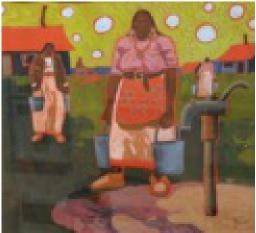
Elder With Mask – Roger Simon
Oil on paper
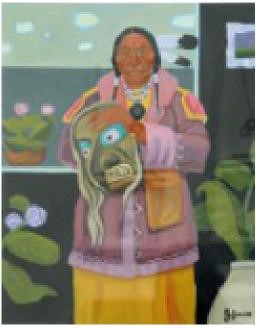
Roger Simon was a Mi’kmaq artist from Elsipogtog First Nation. He studied at the George Brown College in Toronto, and continued at the New Brunswick College of Craft and Design in Fredericton. His work combined traditional and contemporary ideas where he painted the faces of people from Big Cove and other reserves that impressed him. His ideas stemmed from Mi’kmaq legends and stories from the Elders and he interpreted ideas from his culture in new ways. His inspiration came from the beauty of his people.
Simon’s painting style was unique and his paintings are greatly appreciated by both the First Nations’ and non-aboriginal communities. In 1995, one of his paintings, “The First Car on the Rez” (oil on paper, 1993), was selected by the Department of Foreign Affairs and International Trade’s Fine Art program for a permanent exhibition of First Nations’ art for the Canadian Embassy in Moscow, Russia .
Simon’s work was displayed in several group and solo exhibitions and is found in various permanent public and corporate collections, while his murals remain on display in many Native organizations and at the Miramichi Hospital.
Roger Simon died in January, 2000. His death was a great loss to the Canadian art scene and for those who knew and loved him. His art will provide inspiration to others for many generations.
